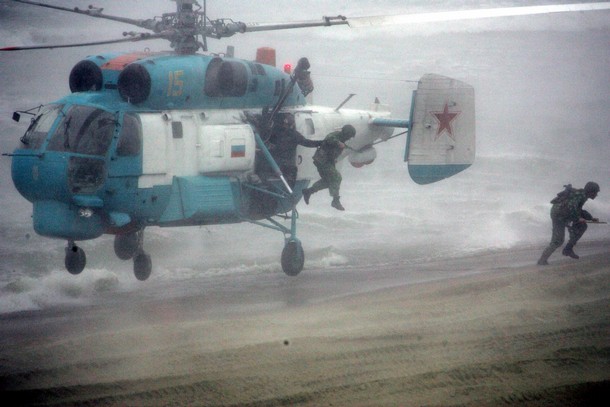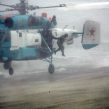
Belarus and Russia Prepare Zapad 2013 Military Exercise
Publication: Eurasia Daily Monitor Volume: 10 Issue: 71
By:

Belarus and Russia will stage a joint military exercise on Belarusian territory in September, allegedly to rehearse a defense against a Polish attack on the country. Controversy concerning plans for Zapad 2013 relate to the issue of whether Moscow will repeat the pattern from Zapad 2009 and also rehearse a pre-emptive nuclear attack on Poland. On April 4, the Belarusian defense ministry issued a statement to refute this claim in response to an article that appeared on a Polish news website (Interfax, April 8).
Belarusian President Alyaksandr Lukashenka approved the scenario for the exercise in February 2013, though bilateral plans for Zapad 2013 were finalized in October 2012. Unlike Zapad 2009, this year’s exercise will feature the regional group of forces of Belarus and Russia as well as the Collective Security Treaty Organization (CSTO) rapid reaction forces. However, Lukashenka stressed that the exercise poses “no threat to other countries,” and in accordance with the country’s military doctrine “we do not view any state as our enemy” (Interfax, April 8).
Zapad 2009 involved a total of 12,500 servicemen, including 6,000 from Russia, and 40 aircraft among 200 items of military hardware. The exercise was designed to promote interoperability between Russian and Belarusian military forces, as well offer an opportunity for Moscow to test the transition to a brigade-based structure in the Armed Forces. The exercise also allowed Moscow to examine changes to its air defense and air force command structures. Zapad 2009 was linked to a simultaneous Russian military exercise Ladoga 2009, and the exercises were split into two component parts in order to circumvent reporting requirements. Controversy over Zapad 2009 was linked to the Russian simulated nuclear strike on Poland. When North Atlantic Treaty Organization (NATO) officials first attempted to bring together the Russian and Polish delegations at NATO to defuse the tension created by the exercise, Dmitry Rogozin, the then Russian ambassador to the North Atlantic Alliance, dismissed his Polish counterparts as “political dwarves” (see EDM, September 30, 2009).
The doctrinal basis for Zapad 2013 is to rehearse the defense of the Union State of Belarus and Russia in response to a “military-political situation,” involving two phases conducted in each country and using 9,000 troops. Despite Lukashenka’s efforts to offer reassurance concerning the exercise scenario, he has also apparently sought to expand Zapad 2013 to include “territorial defense,” which would test the “mobilization” capacity of the Belarusian state. One indication of the potentially offensive tactical features of Zapad 2013 relates to the use of some force elements. The commander of the Russian Airborne Forces, Colonel-General Vladimir Shamanov, noted that an amphibious assault company will participate in the exercise, which could be reinforced, suggesting that coastal assaults will feature in the scenario (https://nvo.ng.ru/forces/2013-04-05/10_zapad2-13.html).
According to Vladimir Agamalyan, the director-general of defense contractor OOO YuVS AVIA, Zapad 2013 will witness the testing of a Russian manufactured quadcopter. The quadcopter is a vertical take-off and landing platform with four rotors with two-bladed lift propellers in each, currently under production in Russia based upon German technology. “A concept of the reconnaissance of terrain during clashes in hard-to-reach and urban areas with the use of a group of quadcopters has been drawn up. Even the loss of one craft can be compensated for by video information from other craft in the group,” explained Agamalyan (Interfax, March 6).
The real roots of the controversy surrounding Zapad 2013 lie in Zapad 2009, which concluded with a Russian rehearsal of a pre-emptive nuclear strike on Poland; and in many neighboring countries there is anxiety that this year’s exercise may witness a similar nuclear element. However, a recent article in Nezavisimoye Voyennoye Obozreniye suggests that the bilateral planning for Zapad 2013 takes into consideration recent NATO exercises in the Baltic and in Eastern Europe (https://nvo.ng.ru/forces/2013-04-05/10_zapad2-13.html).
Minsk and Moscow have cautiously followed such NATO exercises, and clearly discussed this during the planning meetings for Zapad 2013. Its conclusions were that in “close” proximity to the borders of Belarus more than twelve military exercises took place involving NATO members. Minsk particularly noted that in Poland in 2012, a German-Danish-Polish “NATO rapid reaction corps” staged “Little Eagle 2012”; a multinational force exercise, “Team Challenge 2012,” occurred under a European Union banner; and a command staff exercise of NATO Special Operations Forces “Puma 2012” was held. Moreover, the biennial exercise “Anaconda 2012,” held in Poland in September 2012, was seen as similar in scale to Zapad 2009 (https://nvo.ng.ru/forces/2013-04-05/10_zapad2-13.html).
Warsaw’s claims concerning the exercise scenario for Anaconda 2012 were ridiculed in the article in Nezavisimoye Voyennoye Obozreniye, which concluded that the scenario was far-fetched as Belarus has no territorial claims against Poland. But the same article also provides a clue concerning the fundamental driver of the nuclear element in the Zapad scenario. The NATO “Steadfast Jazz 2013,” scheduled for November, is portrayed as “anti-Russian” and “anti-Belarusian,” because the goal of the exercise includes the development of a “large-scale strategic offensive in the East, blocking the Kaliningrad region,” and “isolating” the Baltic Fleet (https://nvo.ng.ru/forces/2013-04-05/10_zapad2-13.html). The clear but unstated implication in the article is that the Russian military has no alternative means to break a NATO-led siege of Kaliningrad other than resorting to nuclear first use; and despite official denials, this may well be tested during Zapad 2013.




